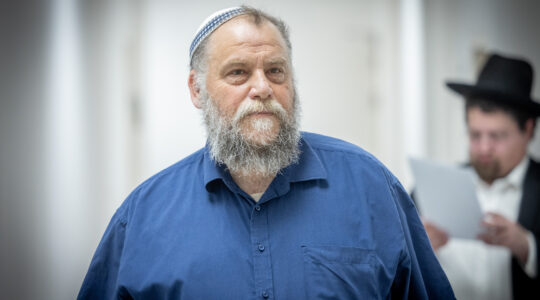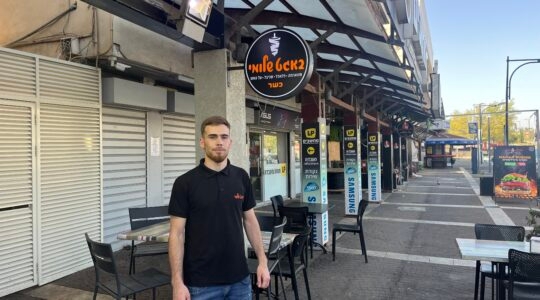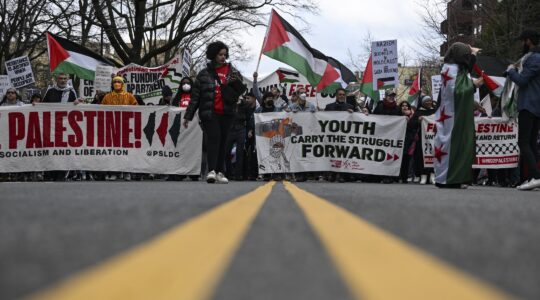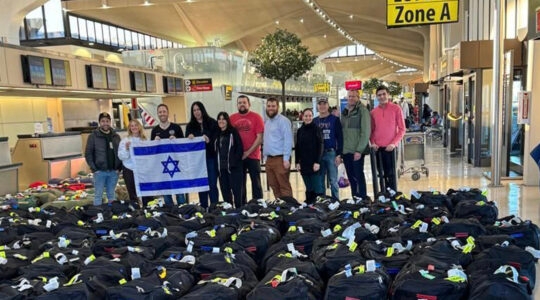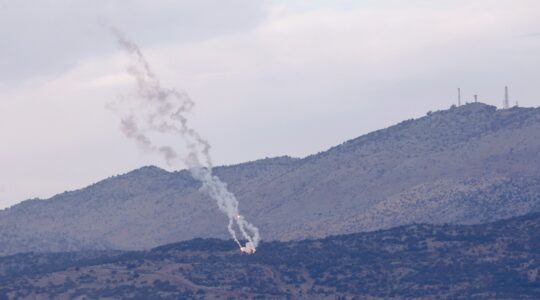NITZAN, Israel (JTA) – Stuart and Anita Tucker’s 970-square-foot prefab on an artichoke field in Kibbutz Ein Tzurim looks like home.
Paintings and pictures hang on the walls of the living and dining rooms. Colorful magnets hold up flyers and pieces of note paper on the white refrigerator. A new air conditioner hums in the background.
Though many of their friends surround themselves with photographs of their former life in Gush Katif in the Gaza Strip, the Tuckers display not one picture of the home that the couple lived in for 29 years in what was commonly known as “the Gush.”
“I’m a forward person, not a past person,” Anita Tucker says.
But in a nod to the past and to the present situation, the hand-painted paper nameplate on the front door of the temporary dwelling is draped with a single orange ribbon – the symbol of the struggle for Gush Katif.
This month marks two years since Israel’s disengagement from the Gaza Strip in a painful and divisive operation that removed more than 8,000 Jewish settlers from their homes – some of them with force by Israeli soldiers and police.
It was hailed as a watershed moment, the first time Israel had withdrawn unilaterally from territory seized during the 1967 Six-Day War. But now, with last year’s war against Hezbollah in Lebanon and this summer’s Hamas takeover of the Gaza Strip, many Israelis are skeptical about the prospects for peace.
Many of the more than 1,600 families who were forced from their homes are trying to rebuild their lives. Some have become even more bitter. Most families do not have a permanent housing solution, more than a third remain unemployed and many worry that the government continues to discuss further withdrawals in the name of peace.
While some families are staying positive about the future, with a small number having successfully moved on, others are in dire straits. Some rely on charity to put food on the table, and have had to use the advance payments for their homes to pay the electric and water bills. Others have become physically ill, with higher-than-average reported cases of diseases such as diabetes, cancer and heart disease.
Dror Vanunu, the international coordinator for the Gush Katif Committee that represents the residents of the former communities and coordinates relief efforts, says his organization is working with the government, as well as with organizations such as the United Jewish Communities and the Jewish Agency for Israel, to address the needs of the evacuees.
The UJC, the umbrella of the North American federation system, has allocated some $4.5 million to help those in need. Funds have gone to an array of programs, including for psychological counseling, cultural and youth activities, and financial aid.
After the expulsion, Vanunu says, most private support came from Orthodox Jewish individuals and institutions. Even now, he says, “many people cannot believe that after two years Israel has not been able to cope. They think the problem has been solved.”
Next door to the Tuckers, in the caravilla of Bryna and Sammy Hilberg, a small sitting room holds the only tangible reminders of Gush Katif: Against the backdrop of sea-blue paint hangs a fisherman’s net across the wall.
Attached to the net are the treasures collected by the family on the beaches of Gush Katif over the 26 years they lived in Netzar Hazoni. Curved around the sea shells, the sea sponges and the sparkling smooth rocks is a thick rope that washed ashore one day, perhaps from the deck of a passing vessel.
The Hilbergs look settled and comfortable in the prefab structure they moved into a little more than a year ago. But, Bryna Hilberg says, “This is not home.
“We did not choose to live here,” she says. “We chose to be in Gush Katif. We were dumped.”
For the Hilberg family, this week also marks 10 years since the death of their son, Yochanan, a soldier in Lebanon. They will visit his new gravesite in Nitzan, the southern Israeli town where his body was reburied after the evacuation.
They still lament the loss of the youth center they had built in their former community in Yochanan’s memory. It was torn down “in 10 seconds,” his mother says.
For two years they have been trying to re-create it in their community of caravillas, the term used to describe the prefab housing erected for the evacuees.
“How much longer can we wait?” Bryna Hilberg despairs. “It is not comfortable for the kids. Where can they put themselves?”
A 10-minute drive from the Ein Tzurim caravilla site, the Nitzan Caravilla Park’s tightly packed, red-roofed structures stand out against the surrounding green landscape. Most of the homes have lush, creeping vines and colorful flowers decorating their fences and their yards. There are sidewalks and streets, with signs sporting neutral names that come from nature. But the public areas remain dusty sand lots and abandoned shipping containers dot the area.
According to the Gush Katif Committee, the 1667 families who left Gush Katif are scattered in 20 housing locations around the country. Their goal is to resettle together in 26 new communities, mostly in southern Israel.
In a report this month, the committee says that only 12 families have begun construction of their permanent homes.
Contracts involving the state, the residents and the communities have been signed on only seven of the 26 areas slated for permanent housing. In some cases it is the residents, seeking better terms, who have held up the contract. In other cases it is the community trying to renege on the agreement.
“Government neglect” is how former Neve Dekalim resident Rachel Saperstein describes the holdup. Neve Dekalim residents who plan to build in Lahish, near Ashkelon, delayed signing until the government agreed to permit 40 long-term renters to build in their permanent communities.
Environmental protesters are now asking the government not to allow the community to build because it will reduce the amount of green space.
Many of the Gush families have received an advance on their compensation checks while the final amounts remain in dispute.
Families were supposed to receive between $200,000 and $250,000 from the government, an amount that can increase depending on the size of their previous homes and property and how long they lived in Gaza. Many families say they have received only partial payouts.
Most of those who have received funds have had to use the money for everyday expenses rather than putting it toward their future homes.
Saperstein began Operation Dignity while living at the Jerusalem Gold Hotel with dozens of other evacuated families. Most evacuees arrived only with what they could carry. The cash they brought to Saperstein at the hotel helped families purchase diapers, warmer clothing and other necessities during the seven months they spent living in hotels while waiting for their caravillas and possessions.
With unemployment among the evacuees at 37 percent, according to the Gush Katif Committee report, Operation Dignity helps families with immediate needs. They have ranged from purchasing medicines and eyeglasses to helping pay for a brit milah or wedding. Saperstein pays the grocery bills for several families.
Operation Dignity has also established the “Orange Gallery,” including the purchase of a structure, to employ the many artists and artisans from the Gush Katif communities. Saperstein has also established an embroidery workshop to employ the 40 Bnei Menashe members, originally from India, of her former Neve Dekalim community.
The volunteer Jobkatif organization has also been instrumental in finding employment or retraining opportunities for the evacuees. Stuart Tucker, who worked as a teacher in two Gush Katif schools, recently completed a subsidized course and passed his licensing test to be a tour guide.
Still, 850 evacuees – 350 of whom are in retraining courses – are looking for jobs, according to the report. Another 400 older than 50 or with job skills specific to Gush Katif are having a difficult time finding employment.
Among the 400 evacuees who were farmers, 33 have received land from the state for new farms. The farmers were not compensated for the loss of equipment, and they also had to find new markets after a two-year absence.
Anita Tucker, a celery farmer, is still waiting for her land allocation and says she was compensated for only 60 percent of the value of her former business. Sammy Hilberg, a boutique tomato farmer, is waiting, too.
All of those interviewed say they believe Jews will live again in their former Gush Katif communities; the Gaza Strip is now controlled by Hamas. At the same time they are ready to pick up their shattered lives and move forward.
“Two years. We all thought we would be in permanent homes,” Tucker says. “We had faith in the State of Israel even after they did this to us.”
Saperstein says many of her neighbors today feel a sense of shame that they allowed themselves to be evacuated.
“We should have fought physically. We should not have allowed the army to take us out,” the grandmother of 12 says, her voice rising. “We wanted to be decent people.”
“I think this is why we hate ourselves.”
